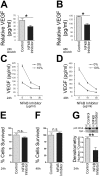Stretch-induced hypertrophy activates NFkB-mediated VEGF secretion in adult cardiomyocytes
- PMID: 22174951
- PMCID: PMC3236775
- DOI: 10.1371/journal.pone.0029055
Stretch-induced hypertrophy activates NFkB-mediated VEGF secretion in adult cardiomyocytes
Abstract
Hypertension and myocardial infarction are associated with the onset of hypertrophy. Hypertrophy is a compensatory response mechanism to increases in mechanical load due to pressure or volume overload. It is characterized by extracellular matrix remodeling and hypertrophic growth of adult cardiomyocytes. Production of Vascular Endothelial Growth Factor (VEGF), which acts as an angiogenic factor and a modulator of cardiomyocyte function, is regulated by mechanical stretch. Mechanical stretch promotes VEGF secretion in neonatal cardiomyocytes. Whether this effect is retained in adult cells and the molecular mechanism mediating stretch-induced VEGF secretion has not been elucidated. Our objective was to investigate whether cyclic mechanical stretch induces VEGF secretion in adult cardiomyocytes and to identify the molecular mechanism mediating VEGF secretion in these cells. Isolated primary adult rat cardiomyocytes (ARCMs) were subjected to cyclic mechanical stretch at an extension level of 10% at 30 cycles/min that induces hypertrophic responses. Cyclic mechanical stretch induced a 3-fold increase in VEGF secretion in ARCMs compared to non-stretch controls. This increase in stretch-induced VEGF secretion correlated with NFkB activation. Cyclic mechanical stretch-mediated VEGF secretion was blocked by an NFkB peptide inhibitor and expression of a dominant negative mutant IkBα, but not by inhibitors of the MAPK/ERK1/2 or PI3K pathways. Chromatin immunoprecipitation assays demonstrated an interaction of NFkB with the VEGF promoter in stretched primary cardiomyocytes. Moreover, VEGF secretion is increased in the stretched myocardium during pressure overload-induced hypertrophy. These findings are the first to demonstrate that NFkB activation plays a role in mediating VEGF secretion upon cyclic mechanical stretch in adult cardiomyocytes. Signaling by NFkB initiated in response to cyclic mechanical stretch may therefore coordinate the hypertrophic response in adult cardiomyocytes. Elucidation of this novel mechanism may provide a target for developing future pharmacotherapy to treat hypertension and heart disease.
Conflict of interest statement
Figures






Similar articles
-
Effect of atorvastatin on cardiomyocyte hypertrophy through suppressing MURC induced by volume overload and cyclic stretch.J Cell Mol Med. 2019 Feb;23(2):1406-1414. doi: 10.1111/jcmm.14044. Epub 2018 Dec 3. J Cell Mol Med. 2019. PMID: 30511410 Free PMC article.
-
Mechanical stretch enhances the expression of resistin gene in cultured cardiomyocytes via tumor necrosis factor-alpha.Am J Physiol Heart Circ Physiol. 2007 Oct;293(4):H2305-12. doi: 10.1152/ajpheart.00361.2007. Epub 2007 Jun 15. Am J Physiol Heart Circ Physiol. 2007. PMID: 17573461
-
Increased myocardial stiffness activates cardiac microvascular endothelial cell via VEGF paracrine signaling in cardiac hypertrophy.J Mol Cell Cardiol. 2018 Sep;122:140-151. doi: 10.1016/j.yjmcc.2018.08.014. Epub 2018 Aug 20. J Mol Cell Cardiol. 2018. PMID: 30138627
-
Role of the renin-angiotensin system in cardiac hypertrophy.Am J Cardiol. 1999 Jun 17;83(12A):53H-57H. doi: 10.1016/s0002-9149(99)00259-3. Am J Cardiol. 1999. PMID: 10750588 Review.
-
Integrins in cardiac hypertrophy: lessons learned from culture systems.ESC Heart Fail. 2021 Oct;8(5):3634-3642. doi: 10.1002/ehf2.13497. Epub 2021 Jul 7. ESC Heart Fail. 2021. PMID: 34232557 Free PMC article. Review.
Cited by
-
Mechanical Stretch Inhibits MicroRNA499 via p53 to Regulate Calcineurin-A Expression in Rat Cardiomyocytes.PLoS One. 2016 Feb 9;11(2):e0148683. doi: 10.1371/journal.pone.0148683. eCollection 2016. PLoS One. 2016. PMID: 26859150 Free PMC article.
-
S-adenosylhomocysteine induces inflammation through NFkB: A possible role for EZH2 in endothelial cell activation.Biochim Biophys Acta. 2016 Jan;1862(1):82-92. doi: 10.1016/j.bbadis.2015.10.019. Epub 2015 Oct 24. Biochim Biophys Acta. 2016. PMID: 26506125 Free PMC article.
-
Vitamin D attenuates pro-inflammatory TNF-α cytokine expression by inhibiting NF-кB/p65 signaling in hypertrophied rat hearts.J Physiol Biochem. 2015 Jun;71(2):289-99. doi: 10.1007/s13105-015-0412-1. Epub 2015 May 1. J Physiol Biochem. 2015. PMID: 25929726
-
The effect of mechanical strain on soft (cardiovascular) and hard (bone) tissues: common pathways for different biological outcomes.Cell Adh Migr. 2013 Mar-Apr;7(2):165-73. doi: 10.4161/cam.23020. Epub 2013 Jan 3. Cell Adh Migr. 2013. PMID: 23287581 Free PMC article. Review.
-
The Interaction between Fluid Wall Shear Stress and Solid Circumferential Strain Affects Endothelial Gene Expression.PLoS One. 2015 Jul 6;10(7):e0129952. doi: 10.1371/journal.pone.0129952. eCollection 2015. PLoS One. 2015. PMID: 26147292 Free PMC article.
References
-
- Katz AM. The cardiomyopathy of overload: an unnatural growth response in the hypertrophied heart. Ann Intern Med. 1994;121:363–371. - PubMed
-
- Ross RS. The extracellular connections: the role of integrins in myocardial remodeling. J Card Fail. 2002;8:S326–331. - PubMed
-
- Kudoh S, Komuro I, Hiroi Y, Zou Y, Harada K, et al. Mechanical stretch induces hypertrophic responses in cardiac myocytes of angiotensin II type 1a receptor knockout mice. J Biol Chem. 1998;273:24037–24043. - PubMed
-
- Lammerding J, Kamm RD, Lee RT. Mechanotransduction in cardiac myocytes. Ann N Y Acad Sci. 2004;1015:53–70. - PubMed
Publication types
MeSH terms
Substances
Grants and funding
LinkOut - more resources
Full Text Sources
Medical
Miscellaneous

